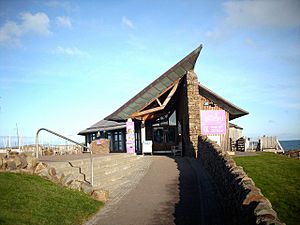Scottish Seabird Centre facts for kids
Quick facts for kids Scottish Seabird Centre |
|
|---|---|

Scottish Seabird Centre
|
|
| General information | |
| Location | The Harbour, North Berwick EH39 4SS, Scotland |
| Construction started | 2000 |
The Scottish Seabird Centre is a special place in North Berwick, Scotland. It's a charity that helps protect the ocean and teaches people about sea creatures. It's also a popular visitor attraction. The centre first opened its doors in the year 2000.
A main highlight of the centre is its live cameras. These cameras let you see amazing wildlife on islands nearby. You can spot birds on places like Bass Rock and the Isle of May. Bass Rock is home to the world's biggest group of Northern gannets. There are about 150,000 of these birds there!
Contents
Building the Centre
The Scottish Seabird Centre was built with care. Workers used materials that were good for the environment. They also tried to use things found close by. The building was designed to let in lots of natural light. It also has great views of the sea and the land. Not much plastic was used in building it. Instead, they chose wood, stone, and metal.
What Was Here Before?
The land where the centre now stands used to be a swimming pool. This outdoor pool was a popular spot in North Berwick Harbour. It was open for many years but closed in 1996. Now, the old pool area is used for boats. It's also home to the Firth of Forth Lobster Hatchery. You can also find colorful beach huts selling local items there. The buildings used for learning and offices were once a sun lounge.
The Scottish Seabird Centre was a big project. It received money from the Millennium Commission. This group gave out money from the UK National Lottery. They supported projects about culture and history. In 2000, a special stamp was made to celebrate the centre's opening. It showed gannets, but the picture was taken in South Africa.
What You Can Do at the Centre
The main part of the Scottish Seabird Centre is the Discovery Experience. It was updated in 2019. Here, you can use interactive cameras. These cameras help you watch seabirds like gannets and puffins. You can see them on the islands in the Firth of Forth. Sometimes, you might even spot seals, dolphins, or whales!
Explore the Exhibits
The Discovery Experience also has many interesting displays. These show you more about Scotland's seabirds. You can also learn about the amazing underwater world. The exhibits cover different topics:
- Seabirds: Learn about how birds travel, live in groups, and find food.
- Threats: Discover what dangers seabirds face. This includes fishing, pollution, and climate change.
- Marine Life: Explore kelp forests, coral reefs, seals, and other sea creatures.
- Discover: See recent animal sightings. Use the live cameras to watch wildlife. Find out what animals are around during different seasons.
There's also a fun kids' zone. You can visit the gift shop for souvenirs. The centre has a cafe with an outdoor deck. From here, you can enjoy views of the Firth of Forth and Bass Rock. On a clear day, you might even see the Isle of May.
Fun Activities and Trips
The centre offers many educational workshops all year. During school holidays, they have live science shows for families. They also host special events and festivals. You can join guided walks, like a free early bird beach walk each month.
The Scottish Seabird Centre also runs wildlife boat trips. These trips go to the islands from Easter to October. They partner with a local company called Seafari Adventures. The centre has special permission to land on Bass Rock. This island is owned by Sir Hew Hamilton-Dalrymple. It's home to the world's largest group of Northern gannets. Landing on Bass Rock is an amazing experience. The number of gannets has grown to 150,000 over the years! You can also take trips to the Isle of May. Or, you can enjoy an hour-long trip around Bass Rock. They have a large catamaran and smaller boats for these trips.
Awards and Recognition
The Scottish Seabird Centre is a very popular place. It has won many awards. These awards are for its work in protecting the environment. They also recognize its efforts in sustainable tourism. For example, it won the Green Tourism Gold Award. It also received the Queen's Award for Enterprise in Sustainable Development. This award was given in 2004, 2009, and 2013. Queen Elizabeth II and Prince Philip visited in 2009. They came to give the centre this special award.
Bass Rock also received an award. It was named BBC Countryfile Magazine's Nature Reserve of the Year for 2014/15.


